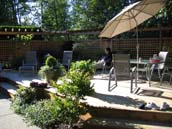|
Comparing Deck Building Materials
In any residential construction project, your choice of materials is critical. It’s no different when building a deck. There is a wide selection of decking available so understanding your options and then choosing the most appropriate building materials is essential. In this article, we’ll take look at wood decking, composite decking, and vinyl decking materials, the benefits of each, and how they stack up against each other. Wood Decking MaterialsWhen the touch and appeal of traditional and natural beauty counts, choose wood decking materials. All-natural hardwoods such as cedar, redwood, and Douglas fir, as well as pressure treated wood are ideally suited for outdoor use. Arsenic-free preservative formulations are also available. Even some exotic hardwoods from the rainforest are available for decking. By nature’s design and intent, wood deck-building materials can endure the punishment of sun, wind and weather. Hardwood grain is tight, dense and durable, and is inherently resistant to rot and decay. Western Red Cedar in particular can be left unfinished. Over time the reddish color fades to a warm silver — a look many people find attractive. When it comes to pressure-treated wood, some types are better than others. Pressure-treated wood is so called because it is exposed to chemicals under high pressure. The chemicals protect the wood from termites and fungal decay. The type of preservative, retention and quality of the treatment are all-important. Prior to 2004, wood treated with chromated copper arsenate (CCA), also called ‘green-treated’ wood was available. Since then, CCA lumber has been banned by the U.S. Environmental Protection Agency (EPA) for residential use, and replaced with two other low-toxicity preservatives: alkaline copper quat (ACQ), and copper azole. These two types of treated lumber are sold under the name Preserve, NatureWood, and Natural Select and cost a bit more than CCA wood. There are different grades of pressure-treated wood for different uses, identified by a chemical retention level. The lowest chemical-retention level is for decking and the highest level is for ground contact lumber and permanent wood foundations. To keep wood decking looking its best, you can apply a water-repellant treatment, and then stain or paint. For annual cleaning and maintenance, pressure-wash for mildew and mold buildup and reapply an oil-penetrating stain. Composite Decking MaterialsAfter wood, composite decking materials are the next-in-line choice for many, as they offer a practical and affordable middle ground, without sacrificing quality or appearance. Composite decking is a smooth and wood-grain like material, from recycled material (woods and post-consumer products). The brands Trex and ChoiceDeck are a slightly more expensive wood and plastic combination. Does it offer the same look and feel as wood? That’s a matter of taste. You’re best bet is to head to a dealer or builder’s supply and see for yourself. Some people are of the opinion that composite material does not offer the same look as wood, but it is highly durable, and does not require sealing, staining or painting. Composite decking is also available in a variety of colors, which fade to a natural gray after over time – so it generally ‘ages’ well – leaving you with lots of options for creative expression and personal styling. It has very low maintenance requirements and needs just an annual cleaning. Vinyl Decking MaterialsFinally, vinyl decking materials are easily the best choice for saving the most on long-term costs and low maintenance overall. If you’re on a tight budget, consider that PVC vinyl usually has a lifetime decking guarantee and a longer projected life and use than wood. Vinyl decking is generally resistant and robust against dry-rot, fungus, mold and mildew, graffiti and termites, and contain no harmful chemicals. Other advantages include simple installation and skid-resistant surface that is cool to the touch, and…no painting required! For more information on building a deck, please read this article on how to build a deck.
|
|
|||||||||||||
|
|||||||||||||||
|
|
|||||||||||||||



